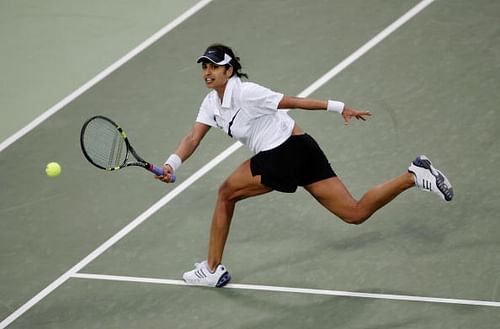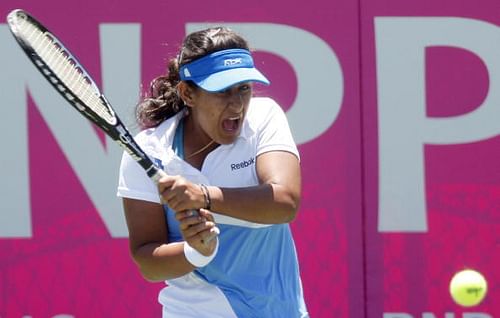
The disappearing players of Indian Women's Tennis

Shikha Uberoi
While Indian women’s badminton has already found the successors to Saina Nehwal in the form of world no. 16, P V Sindhu, and other upcoming players such as P C Thulasi and Arundhati Pantawane, Indian women’s tennis has remained a one-woman show. So what happened to women’s tennis and the promise that it showed with the advent of Sania Mirza? There was a time in 2007 when we had 3 female players in the top 200 (Sania Mirza, Shikha Uberoi and Sunitha Rao) and just 1 male player in the top 300 (Rohan Bopanna). The picture, since then, has changed dramatically with men’s tennis finding new stars like Somdev Devvarman and Yuki Bhambri and the women’s side failing to retain even the most talented. The picture is so horrifying that at one time in 2011, we had no player in the top 650 after Mirza. Now, of course, she has given up singles and we have 2 players in the top 500 (Rishika Sunkara and Ankita Raina) to carry the nation’s hopes in that category.
But what really happened to Indian women tennis? To understand it, one needs to retrospect a bit.
In 2006, India’s Fed Cup team did what they had never done before – finish as runners-up – in the Asia-Oceania Group I, thanks to the efforts of Shikha Uberoi and Sania Mirza. Similar results followed in the Doha Asian Games where the team clinched silver. In 2007, despite Sania’s absence, our team finished a creditable 4th in the Fed Cup Group I. This period also coincided with several WTA events in the country. In 2008, however, a bizarre rule formulated by the Sports Ministry after the Beijing Olympics made it mandatory for players representing India to hold Indian passports. Indian tennis was the worst hit with both Shikha and Sunitha termed ineligible to play in Fed Cups. In the men’s team, Prakash Amritraj was the biggest casualty. Incidentally, Sunitha Rao achieved her career-best ranking of 140 in the same year and beat Petra Kvitova (the future Wimbledon Champion) in Birmingham even as Shikha Uberoi was plagued by several health issues. As a result of this, in 2009, in the absence of Sania Mirza, the team suffered relegation to Group II. Since then, every alternate year we have made it to Group I, only to be relegated the next year. But is the new rule entirely to blame for the current scenario? How did the men’s side cope so well?

Ankita Bhambri
Had one looked beyond Shikha Uberoi and Sunitha Rao, one would have found a highly talented group of Indian girls ready to enter the big stage. Remember Ankita Bhambri’s heroics against Kaia Kanepi in the WTA Bangalore and against Aravane Rezai in WTA Kolkata? Incidentally, both Kanepi and Rezai have, since then, made it to top 20. Isha Lakhani was in fact, the only one among Sania’s peers to have cracked the top 300 in singles. Another name that made quite a noise, even impressing Flavia Penneta in the 2007 Sunfeast Open, was Tara Iyer. Since then, Iyer made a brief appearance in 2010 Asian Games, only to slide into oblivion once again. Ankita and Isha have now taken to coaching while Ankita’s sister, Sanaa (who made the semis in the French Open 2003 Junior doubles with Sania), is into US college tennis. More recently, in the later part of 2009, Poojashree Venkatesha emerged as a leading force and was on the verge of breaking into top 300 when she got injured. The 21-year-old is yet to play in 2013. The sudden vacuum was evident in 2010 when a 33-year-old Nirupama Sanjeev came out of retirement to play in the CWG and Asian Games. In the next year, Lakhani made a mini-comeback by reaching the finals of the Nationals and was expected to partner Sania in the Olympics, thereby earning a place in the Fed Cup team in 2012. In the end though, it was left to the 34-year-old Rushmi Chakraborty to do the honours with Sania at London. One wonders if the “lack of hunger”- as cited by many – is really the cause of the pathetic state of Indian women tennis. But if a 34-year-old can continue playing, what prompts the younger ones to give up so easily? Lack of financial support or just our mind-set about women’s sports in India? In a recent interview to Neo Prime, Shikha Uberoi cited how they struggled for sponsors even as the limelight was focused on just one person.
The immediate scene is slightly encouraging. Ever since winning the Nationals at the age of 15, Rutuja Bhosale has established her position firmly in the Fed Cup team. In the Australian Open 2012 juniors, she made the doubles semis, and that helped her achieve a career-best of 55. Last year, she was the only Indian woman to reach Round 2 in the WTA Challenger held in Pune. However, since then, Rutuja has not played much, especially skipping juniors’ events. Perhaps due to Fed Cup coach, Enrico Piperno’s advice, she is now back in the juniors’ circuit. Having won the Asian Junior Championship in 2011, Rutuja is expected to play in this year’s edition as well, starting from 15th April in Delhi. Rutuja though, is not the only prodigy in Indian women tennis. Ratnika Batra won the Nationals at the age of 14 in 2008, albeit in a much depleted field. Last year, she made it to round 2 of the French Open Juniors singles – something which perhaps even Sania could not do in her junior days. Since then however, Ratnika (who has a career best of 39 in juniors) has not played in the senior circuit. One wonders where she is. Last year, even Kyra Shroff made a much awaited breakthrough, beating a top 300 player in ITF Banglore. For a short while this year, she was also India’s No 1, with Sania taking a break from singles. But these are only consolatory answers, not solutions to the problems of Indian women tennis. We have lost the Shikhas, the Sunithas and the Poojashrees. Let’s not lose the Rutujas and the Ratnikas.